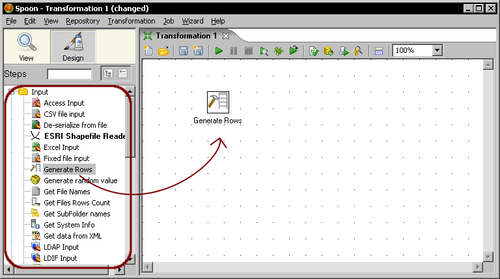

- #PENTAHO DATA INTEGRATION TUTORIAL FOR BEGINNERS FULL#
- #PENTAHO DATA INTEGRATION TUTORIAL FOR BEGINNERS PROFESSIONAL#
Pentaho 5.0 Reporting By Example: Beginner’s Guide lets you learn everything necessary to work seriously with one of the world’s most popular open source reporting tools. and execute your reports from your own web application. You will be able to create your own stoplight type indicators and drill down in your reports. You will also be able to parameterize your reports so that the final user can decide what information to visualize. You will be able to make reports that contain sub-reports, include graphics, sparklines and so on. This book gives you the necessary resources to create a great variety of reports.
#PENTAHO DATA INTEGRATION TUTORIAL FOR BEGINNERS FULL#
Starting with the basics we will explore each feature to ensure a thorough understanding to peel back the curtain and take full advantage of the power that Pentaho puts at our fingertips.

#PENTAHO DATA INTEGRATION TUTORIAL FOR BEGINNERS PROFESSIONAL#
Pentaho 5.0 Reporting By Example: Beginner’s Guide is a step-by-step guide to create high quality, professional reports. Feeling confident with your newly discovered, desirable, skill you will have the power to create your very own professional reports including graphics, formulas, sub-reports and many other forms of data reporting. Pentaho 5.0 Reporting by Example: Beginner’s Guide clearly explains the the foundation and then puts those concepts into practice through step-by-step visual guides. PRD is a very powerful tool and in order to take full advantage of it you need to pay attention to the important details. The Steps in this transform have already been listed above.Open source reporting tools and techniques, such as PRD, have been comparable in quality to their commercial counterparts this is largely due to the market's marked tendency to choose open source solutions.

So let us first take a look how the overall PDI Transformation looks like. Parameterize Source & Target files directory, using Transformation properties- Parameters.Write the result to execution log, using Write to log.Filter only the maximum wettest year, using Filter rows.Generate sequence number for each rows, using Get value from sequence.Sort the data based on the most wettest year, using Sort rows.Get yearly total numbers of rainy days, using Group by.Write data to flat file as pipe delimited using Text file output.Select the columns from dataset to write to target file, using Select/rename Values.Perform a lookup to get the Month name corresponding to the month number, using Stream Value Lookup.Generate static list of values for Month Number & Month Name, using Add constant rows / Datagrid.Split Year-Month column to get the Year & Month component, using Field splitter.Read data from source csv file, using CSV Input.Below are the steps we will be covering in this use case scenario. We will extract the data from this csv file perform some transformation and load data in another flat file. This data-set will help us to quickly get us started with the many basic PDI steps. So for each Year-Month the number of rainy days is available in this dataset. This data-set have comma separated values with 2 columns/fields, namely- month,no_of_rainy_days. In this first PDI hands-on tutorial, we will use a data-set on the monthly number of rainy days in Singapore for a time frame between year 1982 to 2016.


 0 kommentar(er)
0 kommentar(er)
